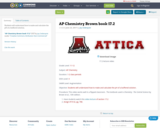
Students will understand how to make and calculate the pH of a buffered solution.
- Subject:
- Applied Science
- Material Type:
- Lecture
- Lesson Plan
- Date Added:
- 06/23/2017

Students will understand how to make and calculate the pH of a buffered solution.

Students will understand how to calculate the pH during different types of acid-base titrations, including guidelines from determining which indicator to use.
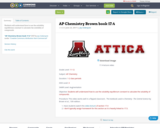
Students will understand how to use the solubility equilibrium constant to calculate the solubility of compounds
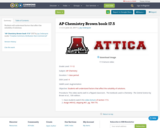
Students will understand factors that affect the solubility of solutions.

Students will understand how to calculate the equilibrium quotient to determine the direction of solubility and solid formation.
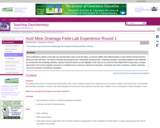
In this field-based exercise, students were given a tour of an abandoned mine site and asked to utilize a set of field measurements to describe the spatial details of metal transport. This drew on previous experience with field measurements and prompted them to work together to solve an observed chemical evolution of a contaminated brook. The exercise is an excellent example for students to bring together acid-base chemistry, redox chemistry, and thermodynamic concepts together to describe a reasonably complex system. The field component was completed in a full day, but we will be expanding this next fall for a 2 day exercise (weekend). The exercise was coupled with subsequent labs to complete analysis of the water samples and accomplish speciation calculations using PHREEQCI.
(Note: this resource was added to OER Commons as part of a batch upload of over 2,200 records. If you notice an issue with the quality of the metadata, please let us know by using the 'report' button and we will flag it for consideration.)
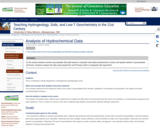
In this activity students examine groundwater flow path based on hydraulic head data/ potentiometric surface and spatial variation of groundwater chemistry. Students analyze the data using AquaChem and Phreeqc which is integrated with AquaChem
(Note: this resource was added to OER Commons as part of a batch upload of over 2,200 records. If you notice an issue with the quality of the metadata, please let us know by using the 'report' button and we will flag it for consideration.)

This is an Excel spreadsheet and graph that illustrates standard "batch" and Rayleigh decarbonation models and how they can be used to detect fluid infiltration during metamorphism of carbonates. It makes a good lecture demonstration, but with a few modifications can be turned into a laboratory exercise. Key variables are "hotlinked" directly into the batch and Rayleigh models so students can adjust them to get a feel for the influence of different model parameters. The included carbon isotope data are from marbles in the Jervois region, central Australia (Cartwright et al., 1997). Oxygen isotope data are also included in the spreadsheet.
(Note: this resource was added to OER Commons as part of a batch upload of over 2,200 records. If you notice an issue with the quality of the metadata, please let us know by using the 'report' button and we will flag it for consideration.)
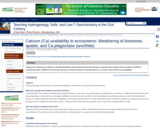
Sequence of laboratory activities to develop familiarity with geochemistry bench laboratory experimental methods; demonstration of different weathering rates of different Ca-bearing minerals; connection between minerals present in a system and nutrient (Ca) availability
(Note: this resource was added to OER Commons as part of a batch upload of over 2,200 records. If you notice an issue with the quality of the metadata, please let us know by using the 'report' button and we will flag it for consideration.)

Based on the 2010 Scientific American paper by Hazen, and the more technical 2008 paper of Hazen et al, both of which explore the effect of the biosphere on the tremendous number of mineral species that occur on Earth compared to the lesser number we believe we are seeing on other planets. This tackles the idea of mineralogy/geochemistry evolving over time as do biological systems, rather than being a static system with no hysteresis or temporal aspect to it. Students work in small groups to decide which groups of minerals have been most affected by a variety of biological influences, and how. Then the class as a whole compares their conclusions group by group.
(Note: this resource was added to OER Commons as part of a batch upload of over 2,200 records. If you notice an issue with the quality of the metadata, please let us know by using the 'report' button and we will flag it for consideration.)
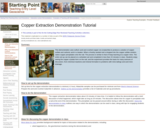
This demonstration uses sulfuric acid and crushed copper ore (malachite) to produce a solution of copper sulfate and carbonic acid in a beaker. When a freshly sanded nail is dropped into the copper sulfate solution, native copper precipitates onto the nail. The process is similar to that of heap leaching at a copper mine. The entire set-up can be placed on a wheeled cart and completed in less than 15 minutes in class. Students enjoy seeing the copper crystals form on the nail, and the experiment provides the basis for many avenues of discussion, from chemical reactions and mineral formation to problems with mine tailings and acid mine drainage.
(Note: this resource was added to OER Commons as part of a batch upload of over 2,200 records. If you notice an issue with the quality of the metadata, please let us know by using the 'report' button and we will flag it for consideration.)

The purpose of this week's lab is to
- prepare calibration standards
- use a UV-Vis spectrometer to determine the spectral peaks for several dye solutions, and create a calibration curve
- calculate how much of each single-element standard solution is needed to make a multi-element stock solution
(Note: this resource was added to OER Commons as part of a batch upload of over 2,200 records. If you notice an issue with the quality of the metadata, please let us know by using the 'report' button and we will flag it for consideration.)
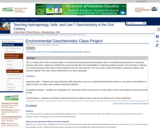
This is a inquiry-driven class research project on a local environmental geochemistry question that is accomplished during three-hour laboratory sessions each week. Students are divided into groups that will share the responsibilities of collecting samples and data. Once the data is collected, it is shared among the entire class so that all students have the same data set. The class works on data presentation, preliminary analysis, and statistics together Then each student writes his/her own report separately.
Outcomes:
Laboratory skills -- Students have basic laboratory skills necessary to carry out a supervised geochemical study (e.g. can perform Gram titration of waters in field, can collect water samples using clean methods).
Quantitative methods -- Students can manipulate, sort, and transfer data in Excel and can create simple x-y plots and histograms to bring out trends in data.
Critical thinking -- Students can develop multiple hypotheses to explain trends in data and can design tests of these hypotheses.
(Note: this resource was added to OER Commons as part of a batch upload of over 2,200 records. If you notice an issue with the quality of the metadata, please let us know by using the 'report' button and we will flag it for consideration.)
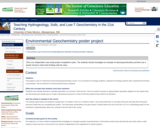
This is an independent case study project completed in pairs. The students should investigate an example of natural geochemistry and then use a poster format to share their findings with the class.
(Note: this resource was added to OER Commons as part of a batch upload of over 2,200 records. If you notice an issue with the quality of the metadata, please let us know by using the 'report' button and we will flag it for consideration.)
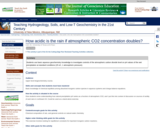
Students use basic aqueous geochemistry knowledge to investigate controls of the atmospheric carbon dioxide level on pH values of the wet precipitation at standard conditions (25 oC, 1 atmospheric pressure).
(Note: this resource was added to OER Commons as part of a batch upload of over 2,200 records. If you notice an issue with the quality of the metadata, please let us know by using the 'report' button and we will flag it for consideration.)
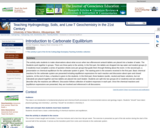
The activity asks students to make observations about what occurs when two effervescent antacid tablets are placed into a beaker of water. The Students work together in groups. There are three parts to the activity. In the first part, the tablets are dropped into tap water and student groups (2-4 students) must complete a series of question sheets (one per group) that guide them through thinking about the event. In the second part, a presentation on chemical equilibrium for the carbonate system is given. The starting point is the answers received in the first part. Basic chemical reactions for the carbonate system are presented including equilibrium expressions for each reaction and discussion about open and closed systems. At the end of class, a handout is given to the students. In the third part, three beakers (acidic, neutral and basic solutions, but not indicated) are placed together and two tablets are placed into each beaker. Students are split into two groups (8-12 students) and are asked to describe why the reactions are different. Discussion follows collection of student responses in each part. Once the chemical reactions and equilibrium expressions are presented, they are involved and referenced in all discussions.
(Note: this resource was added to OER Commons as part of a batch upload of over 2,200 records. If you notice an issue with the quality of the metadata, please let us know by using the 'report' button and we will flag it for consideration.)

In this lab I simply have students dissolve halite and sylvite in water at various temperatures. I use this experiment to introduce students to the principles of equilibrium thermodynamics, as well as basic lab skills, data analysis, and lab report writing. Students use basic laboratory skills to conduct their experiments then analyze their data using a spreadsheet program such as Excel. They then write up their results and discussion in a formal lab report.
(Note: this resource was added to OER Commons as part of a batch upload of over 2,200 records. If you notice an issue with the quality of the metadata, please let us know by using the 'report' button and we will flag it for consideration.)
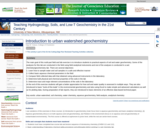
The main goal of this multi-part field and lab exercise is to introduce students to practical aspects of soil and water geochemistry. Some of the analyses for this lab are conducted in the field using field analytical instruments and rest of the analyses is conducted in a wet chemistry/geochemistry lab. There are several objectives:
1. Learn how to sample water and soil samples in a safe and effective manner
2. Collect basic aqueous chemical parameters in the field
3. Compare field collected data with that obtained using advanced instruments in the laboratory
4. Determine bulk physical and chemical properties of the soils in the lab
5. Determine trace and major element concentrations of the soils in the laboratory
At the end of this exercise students will gain a better appreciation for how soil and water quality is assessed in multiple ways. They are also introduced to basic "tools-of-the-trade" in the environmental geochemistry and also using Excel to make simple and advanced calculations as well as for plotting data. During preparation of lab reports, they are introduced to basic elements of an effective data-based technical paper.
Key words: urban watershed, soil chemistry, water chemistry, aqueous geochemistry, field analysis, analytical chemistry
(Note: this resource was added to OER Commons as part of a batch upload of over 2,200 records. If you notice an issue with the quality of the metadata, please let us know by using the 'report' button and we will flag it for consideration.)

Freshmen enrolled in the Spaceship Earth Living Learning Community conduct research on a real project that is formulated and conducted during a 2-semester academic year.
(Note: this resource was added to OER Commons as part of a batch upload of over 2,200 records. If you notice an issue with the quality of the metadata, please let us know by using the 'report' button and we will flag it for consideration.)

Students use the Geochemist Workbench programs React and Act2 to explore the pH dependence of mineral solubility.
(Note: this resource was added to OER Commons as part of a batch upload of over 2,200 records. If you notice an issue with the quality of the metadata, please let us know by using the 'report' button and we will flag it for consideration.)